instrument panel DODGE VIPER 2009 ZB II / 2.G Owners Manual
[x] Cancel search | Manufacturer: DODGE, Model Year: 2009, Model line: VIPER, Model: DODGE VIPER 2009 ZB II / 2.GPages: 299, PDF Size: 5.14 MB
Page 3 of 299
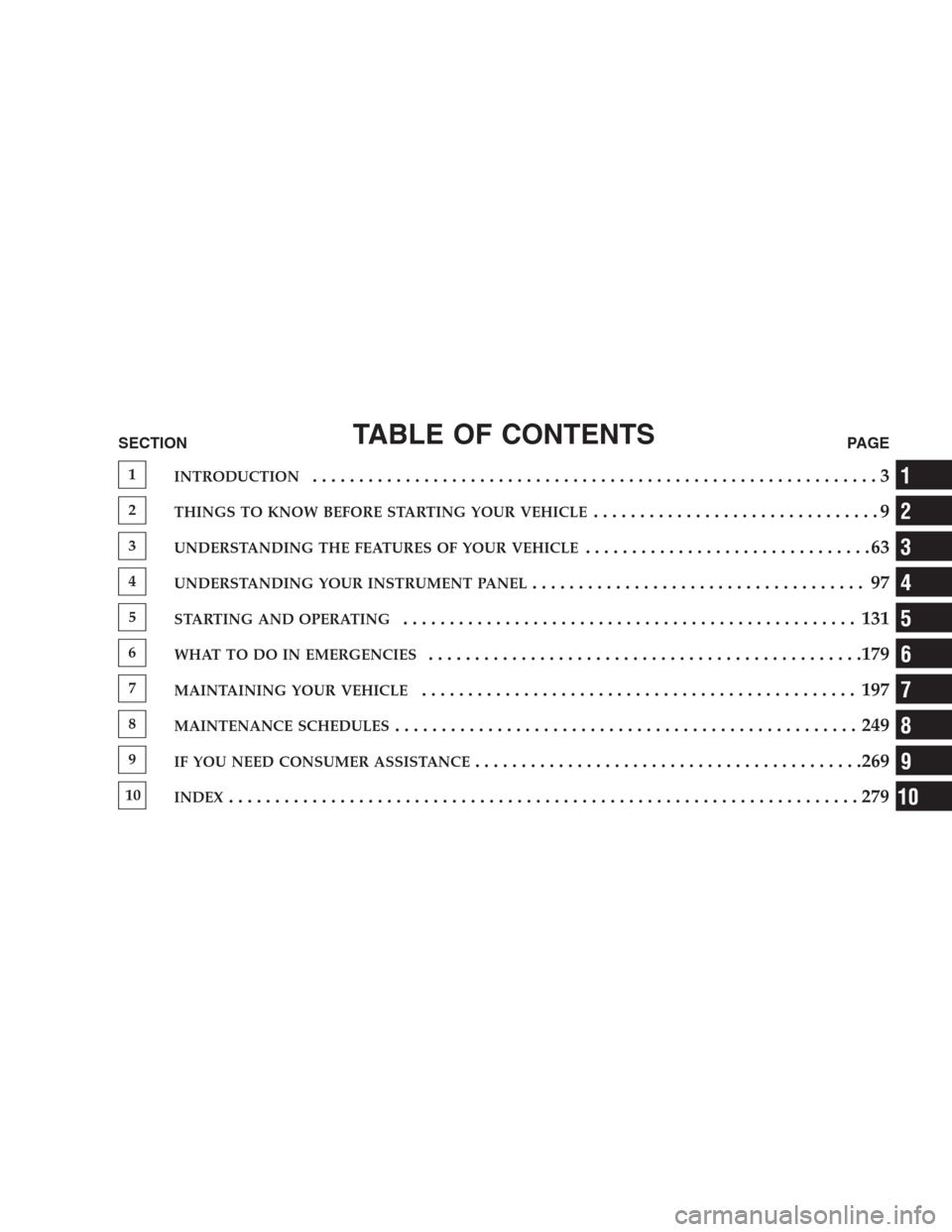
TABLE OF CONTENTSSECTIONPAGE
1INTRODUCTION.............................................................3
2THINGS TO KNOW BEFORE STARTING YOUR VEHICLE...............................9
3UNDERSTANDING THE FEATURES OF YOUR VEHICLE...............................63
4UNDERSTANDING YOUR INSTRUMENT PANEL.................................... 97
5STARTING AND OPERATING................................................. 131
6WHAT TO DO IN EMERGENCIES...............................................179
7MAINTAINING YOUR VEHICLE............................................... 197
8MAINTENANCE SCHEDULES.................................................. 249
9IF YOU NEED CONSUMER ASSISTANCE..........................................269
10INDEX....................................................................279
1
2
3
4
5
6
7
8
9
10
Page 8 of 299
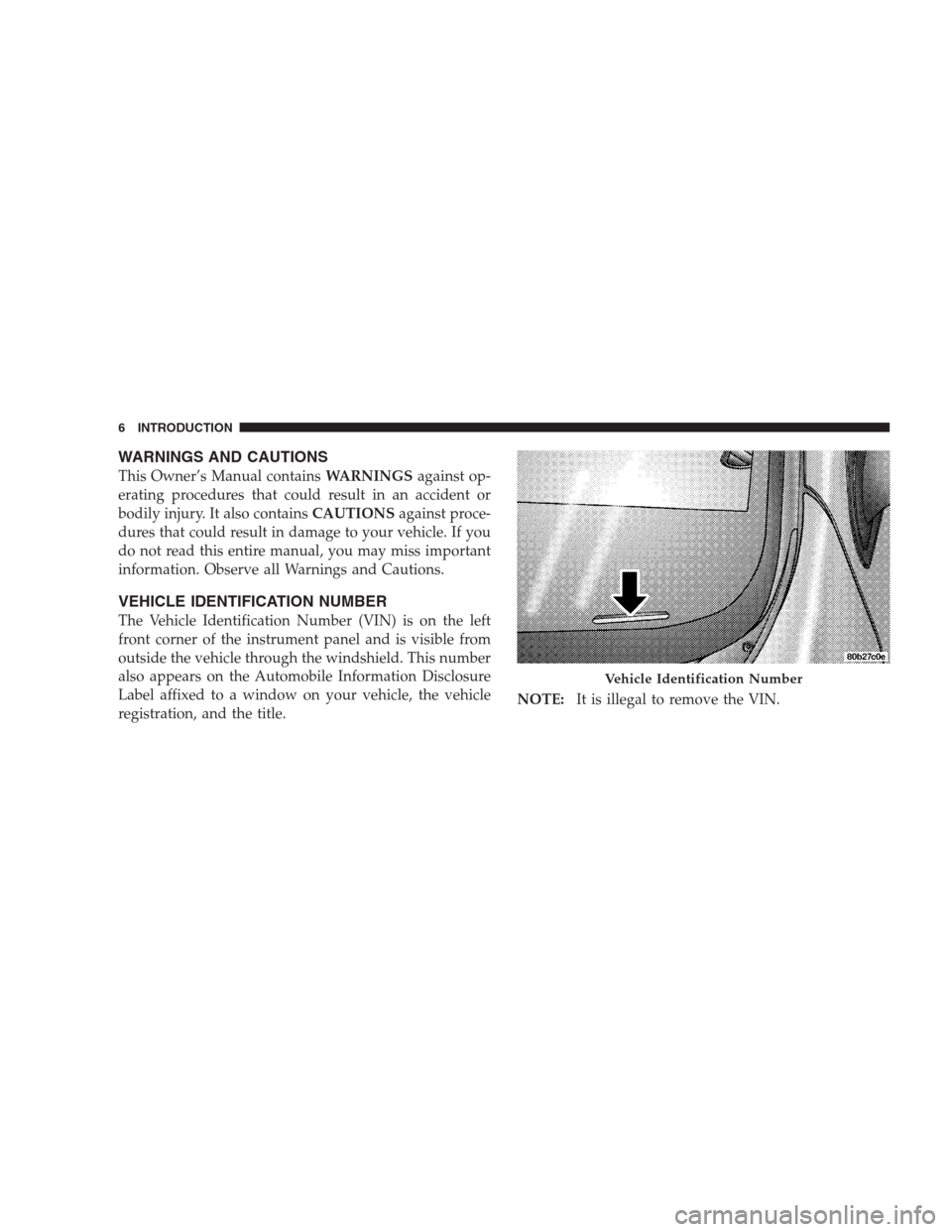
WARNINGS AND CAUTIONS
This Owner’s Manual containsWARNINGSagainst op-
erating procedures that could result in an accident or
bodily injury. It also containsCAUTIONSagainst proce-
dures that could result in damage to your vehicle. If you
do not read this entire manual, you may miss important
information. Observe all Warnings and Cautions.
VEHICLE IDENTIFICATION NUMBER
The Vehicle Identification Number (VIN) is on the left
front corner of the instrument panel and is visible from
outside the vehicle through the windshield. This number
also appears on the Automobile Information Disclosure
Label affixed to a window on your vehicle, the vehicle
registration, and the title.NOTE:It is illegal to remove the VIN.
Vehicle Identification Number
6 INTRODUCTION
Page 44 of 299
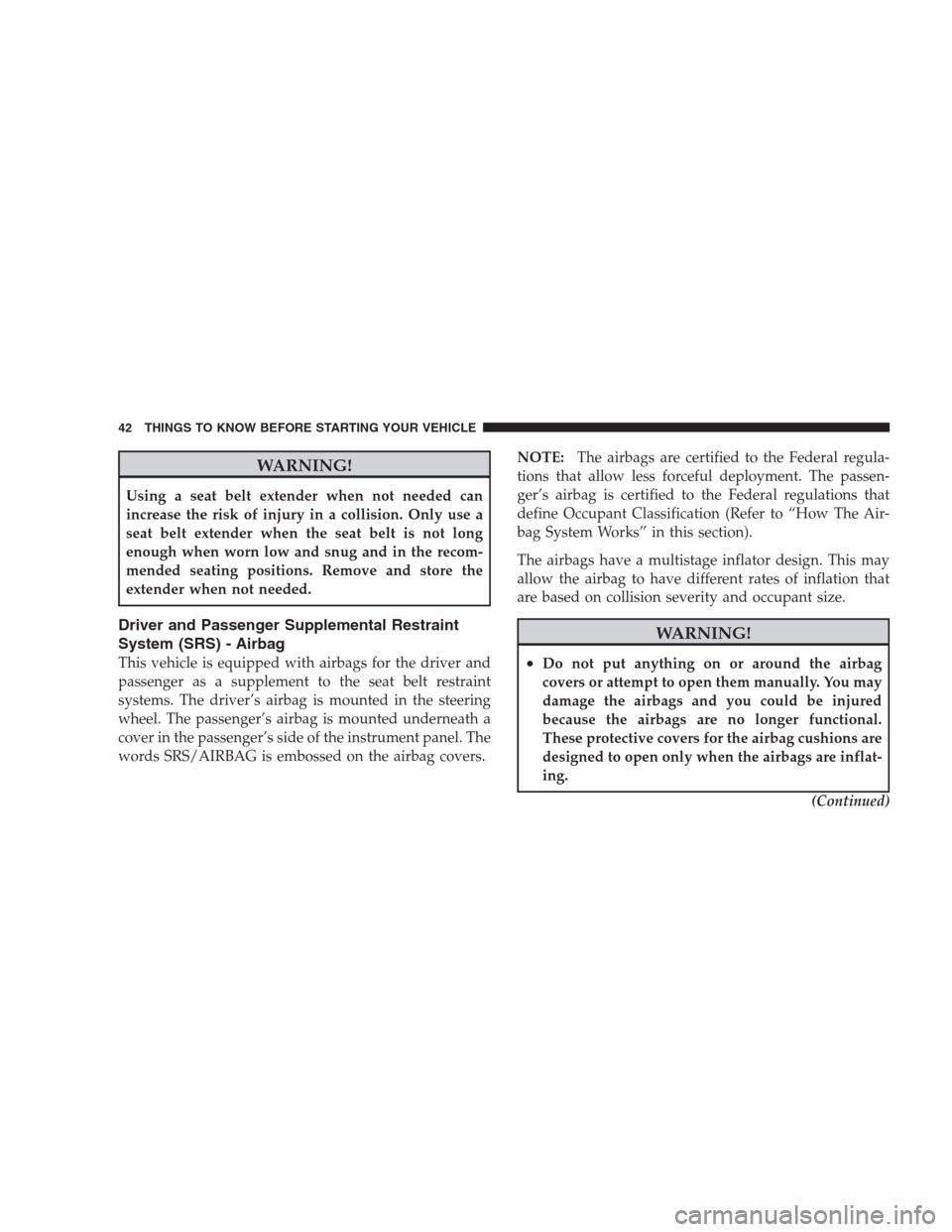
WARNING!
Using a seat belt extender when not needed can
increase the risk of injury in a collision. Only use a
seat belt extender when the seat belt is not long
enough when worn low and snug and in the recom-
mended seating positions. Remove and store the
extender when not needed.
Driver and Passenger Supplemental Restraint
System (SRS) - Airbag
This vehicle is equipped with airbags for the driver and
passenger as a supplement to the seat belt restraint
systems. The driver’s airbag is mounted in the steering
wheel. The passenger’s airbag is mounted underneath a
cover in the passenger’s side of the instrument panel. The
words SRS/AIRBAG is embossed on the airbag covers.NOTE:The airbags are certified to the Federal regula-
tions that allow less forceful deployment. The passen-
ger’s airbag is certified to the Federal regulations that
define Occupant Classification (Refer to “How The Air-
bag System Works” in this section).
The airbags have a multistage inflator design. This may
allow the airbag to have different rates of inflation that
are based on collision severity and occupant size.
WARNING!
•Do not put anything on or around the airbag
covers or attempt to open them manually. You may
damage the airbags and you could be injured
because the airbags are no longer functional.
These protective covers for the airbag cushions are
designed to open only when the airbags are inflat-
ing.
(Continued)
42 THINGS TO KNOW BEFORE STARTING YOUR VEHICLE
Page 45 of 299
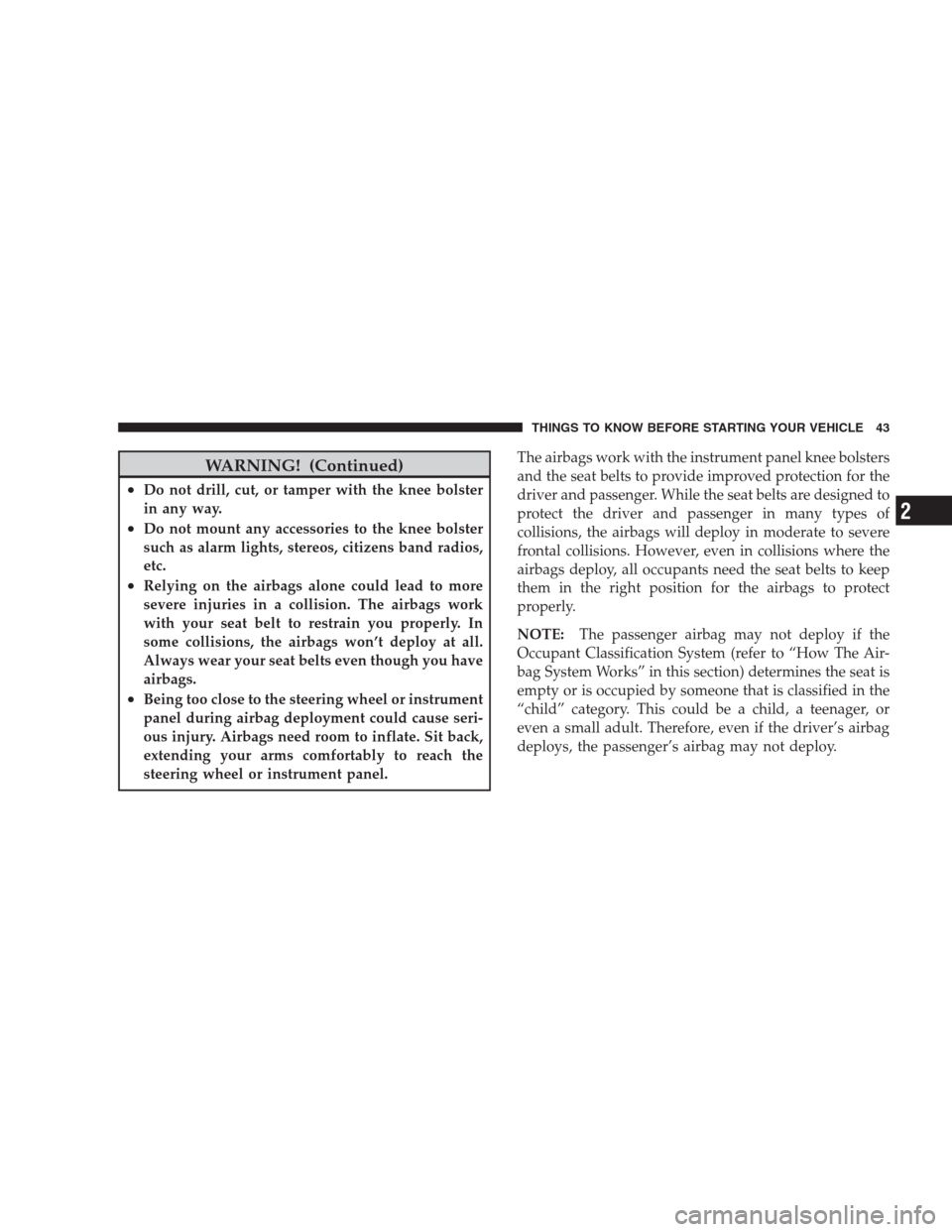
WARNING! (Continued)
•Do not drill, cut, or tamper with the knee bolster
in any way.
•Do not mount any accessories to the knee bolster
such as alarm lights, stereos, citizens band radios,
etc.
•Relying on the airbags alone could lead to more
severe injuries in a collision. The airbags work
with your seat belt to restrain you properly. In
some collisions, the airbags won’t deploy at all.
Always wear your seat belts even though you have
airbags.
•Being too close to the steering wheel or instrument
panel during airbag deployment could cause seri-
ous injury. Airbags need room to inflate. Sit back,
extending your arms comfortably to reach the
steering wheel or instrument panel.The airbags work with the instrument panel knee bolsters
and the seat belts to provide improved protection for the
driver and passenger. While the seat belts are designed to
protect the driver and passenger in many types of
collisions, the airbags will deploy in moderate to severe
frontal collisions. However, even in collisions where the
airbags deploy, all occupants need the seat belts to keep
them in the right position for the airbags to protect
properly.
NOTE:The passenger airbag may not deploy if the
Occupant Classification System (refer to “How The Air-
bag System Works” in this section) determines the seat is
empty or is occupied by someone that is classified in the
“child” category. This could be a child, a teenager, or
even a small adult. Therefore, even if the driver’s airbag
deploys, the passenger’s airbag may not deploy.
THINGS TO KNOW BEFORE STARTING YOUR VEHICLE 43
2
Page 46 of 299
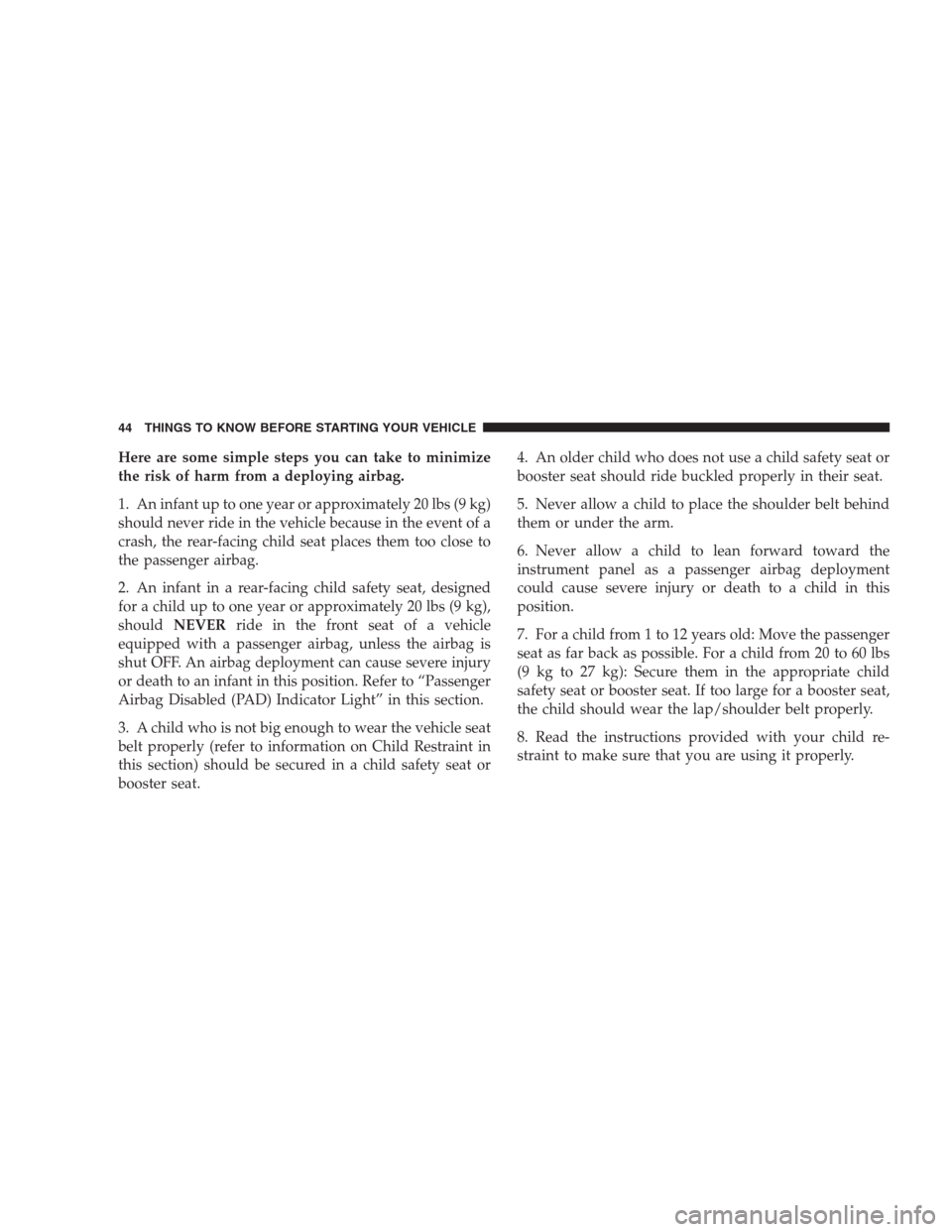
Here are some simple steps you can take to minimize
the risk of harm from a deploying airbag.
1. An infant up to one year or approximately 20 lbs (9 kg)
should never ride in the vehicle because in the event of a
crash, the rear-facing child seat places them too close to
the passenger airbag.
2. An infant in a rear-facing child safety seat, designed
for a child up to one year or approximately 20 lbs (9 kg),
shouldNEVERride in the front seat of a vehicle
equipped with a passenger airbag, unless the airbag is
shut OFF. An airbag deployment can cause severe injury
or death to an infant in this position. Refer to “Passenger
Airbag Disabled (PAD) Indicator Light” in this section.
3. A child who is not big enough to wear the vehicle seat
belt properly (refer to information on Child Restraint in
this section) should be secured in a child safety seat or
booster seat.4. An older child who does not use a child safety seat or
booster seat should ride buckled properly in their seat.
5. Never allow a child to place the shoulder belt behind
them or under the arm.
6. Never allow a child to lean forward toward the
instrument panel as a passenger airbag deployment
could cause severe injury or death to a child in this
position.
7. For a child from 1 to 12 years old: Move the passenger
seat as far back as possible. For a child from 20 to 60 lbs
(9 kg to 27 kg): Secure them in the appropriate child
safety seat or booster seat. If too large for a booster seat,
the child should wear the lap/shoulder belt properly.
8. Read the instructions provided with your child re-
straint to make sure that you are using it properly.
44 THINGS TO KNOW BEFORE STARTING YOUR VEHICLE
Page 47 of 299
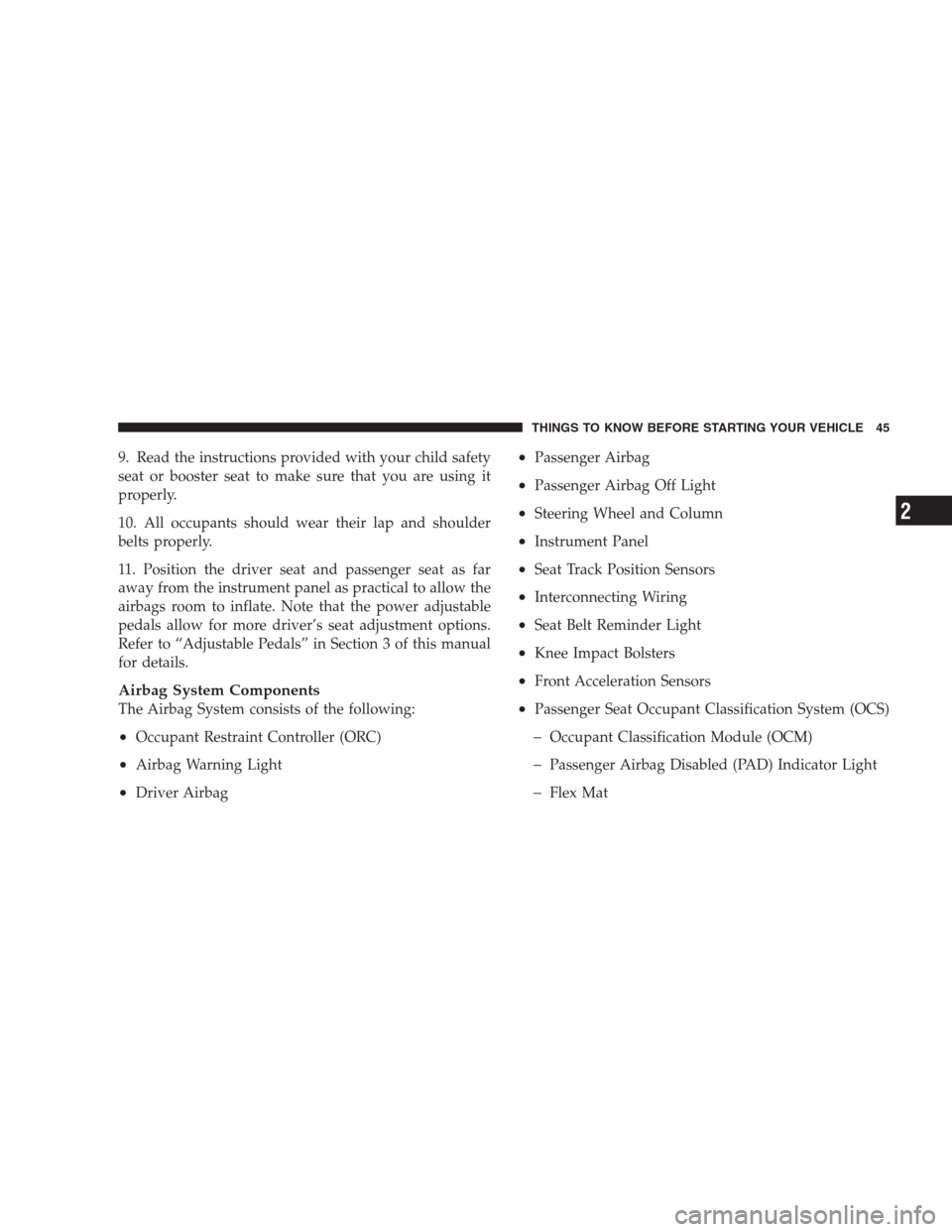
9. Read the instructions provided with your child safety
seat or booster seat to make sure that you are using it
properly.
10. All occupants should wear their lap and shoulder
belts properly.
11. Position the driver seat and passenger seat as far
away from the instrument panel as practical to allow the
airbags room to inflate. Note that the power adjustable
pedals allow for more driver’s seat adjustment options.
Refer to “Adjustable Pedals” in Section 3 of this manual
for details.
Airbag System Components
The Airbag System consists of the following:
•Occupant Restraint Controller (ORC)
•Airbag Warning Light
•Driver Airbag
•Passenger Airbag
•Passenger Airbag Off Light
•Steering Wheel and Column
•Instrument Panel
•Seat Track Position Sensors
•Interconnecting Wiring
•Seat Belt Reminder Light
•Knee Impact Bolsters
•Front Acceleration Sensors
•Passenger Seat Occupant Classification System (OCS)
�Occupant Classification Module (OCM)
�Passenger Airbag Disabled (PAD) Indicator Light
�Flex Mat
THINGS TO KNOW BEFORE STARTING YOUR VEHICLE 45
2
Page 49 of 299
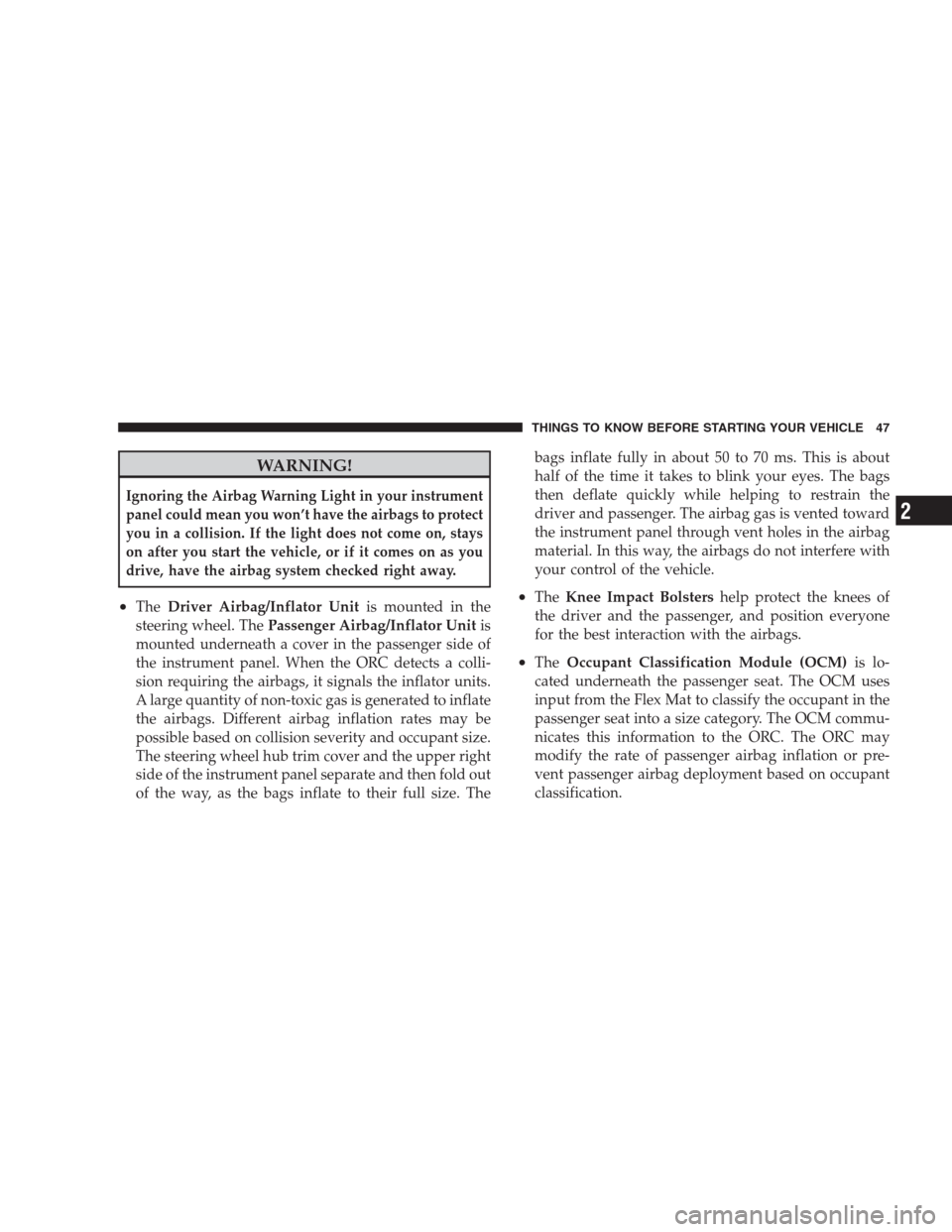
WARNING!
Ignoring the Airbag Warning Light in your instrument
panel could mean you won’t have the airbags to protect
you in a collision. If the light does not come on, stays
on after you start the vehicle, or if it comes on as you
drive, have the airbag system checked right away.
•TheDriver Airbag/Inflator Unitis mounted in the
steering wheel. ThePassenger Airbag/Inflator Unitis
mounted underneath a cover in the passenger side of
the instrument panel. When the ORC detects a colli-
sion requiring the airbags, it signals the inflator units.
A large quantity of non-toxic gas is generated to inflate
the airbags. Different airbag inflation rates may be
possible based on collision severity and occupant size.
The steering wheel hub trim cover and the upper right
side of the instrument panel separate and then fold out
of the way, as the bags inflate to their full size. Thebags inflate fully in about 50 to 70 ms. This is about
half of the time it takes to blink your eyes. The bags
then deflate quickly while helping to restrain the
driver and passenger. The airbag gas is vented toward
the instrument panel through vent holes in the airbag
material. In this way, the airbags do not interfere with
your control of the vehicle.•TheKnee Impact Bolstershelp protect the knees of
the driver and the passenger, and position everyone
for the best interaction with the airbags.
•TheOccupant Classification Module (OCM)is lo-
cated underneath the passenger seat. The OCM uses
input from the Flex Mat to classify the occupant in the
passenger seat into a size category. The OCM commu-
nicates this information to the ORC. The ORC may
modify the rate of passenger airbag inflation or pre-
vent passenger airbag deployment based on occupant
classification.
THINGS TO KNOW BEFORE STARTING YOUR VEHICLE 47
2
Page 51 of 299
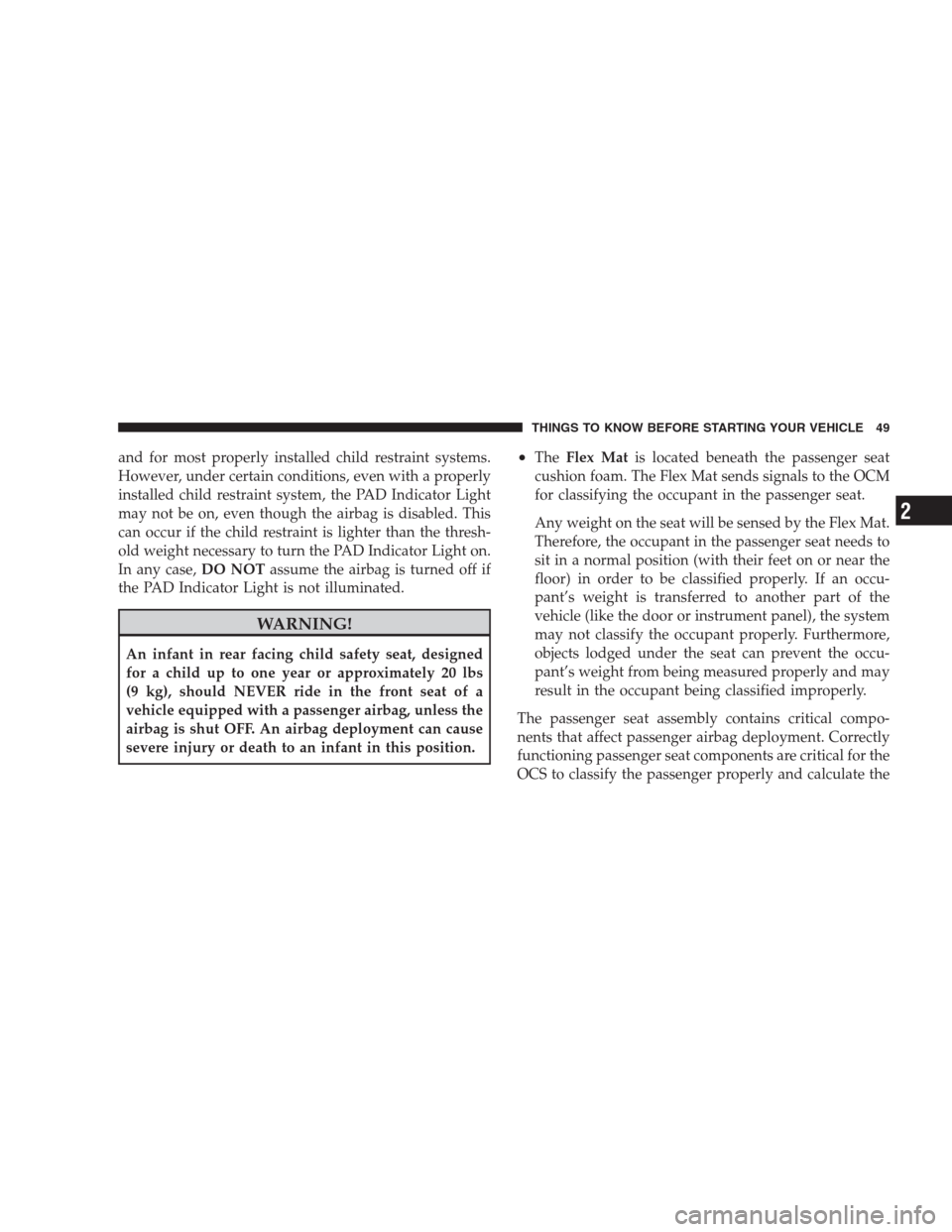
and for most properly installed child restraint systems.
However, under certain conditions, even with a properly
installed child restraint system, the PAD Indicator Light
may not be on, even though the airbag is disabled. This
can occur if the child restraint is lighter than the thresh-
old weight necessary to turn the PAD Indicator Light on.
In any case,DO NOTassume the airbag is turned off if
the PAD Indicator Light is not illuminated.
WARNING!
An infant in rear facing child safety seat, designed
for a child up to one year or approximately 20 lbs
(9 kg), should NEVER ride in the front seat of a
vehicle equipped with a passenger airbag, unless the
airbag is shut OFF. An airbag deployment can cause
severe injury or death to an infant in this position.
•TheFlex Matis located beneath the passenger seat
cushion foam. The Flex Mat sends signals to the OCM
for classifying the occupant in the passenger seat.
Any weight on the seat will be sensed by the Flex Mat.
Therefore, the occupant in the passenger seat needs to
sit in a normal position (with their feet on or near the
floor) in order to be classified properly. If an occu-
pant’s weight is transferred to another part of the
vehicle (like the door or instrument panel), the system
may not classify the occupant properly. Furthermore,
objects lodged under the seat can prevent the occu-
pant’s weight from being measured properly and may
result in the occupant being classified improperly.
The passenger seat assembly contains critical compo-
nents that affect passenger airbag deployment. Correctly
functioning passenger seat components are critical for the
OCS to classify the passenger properly and calculate the
THINGS TO KNOW BEFORE STARTING YOUR VEHICLE 49
2
Page 64 of 299
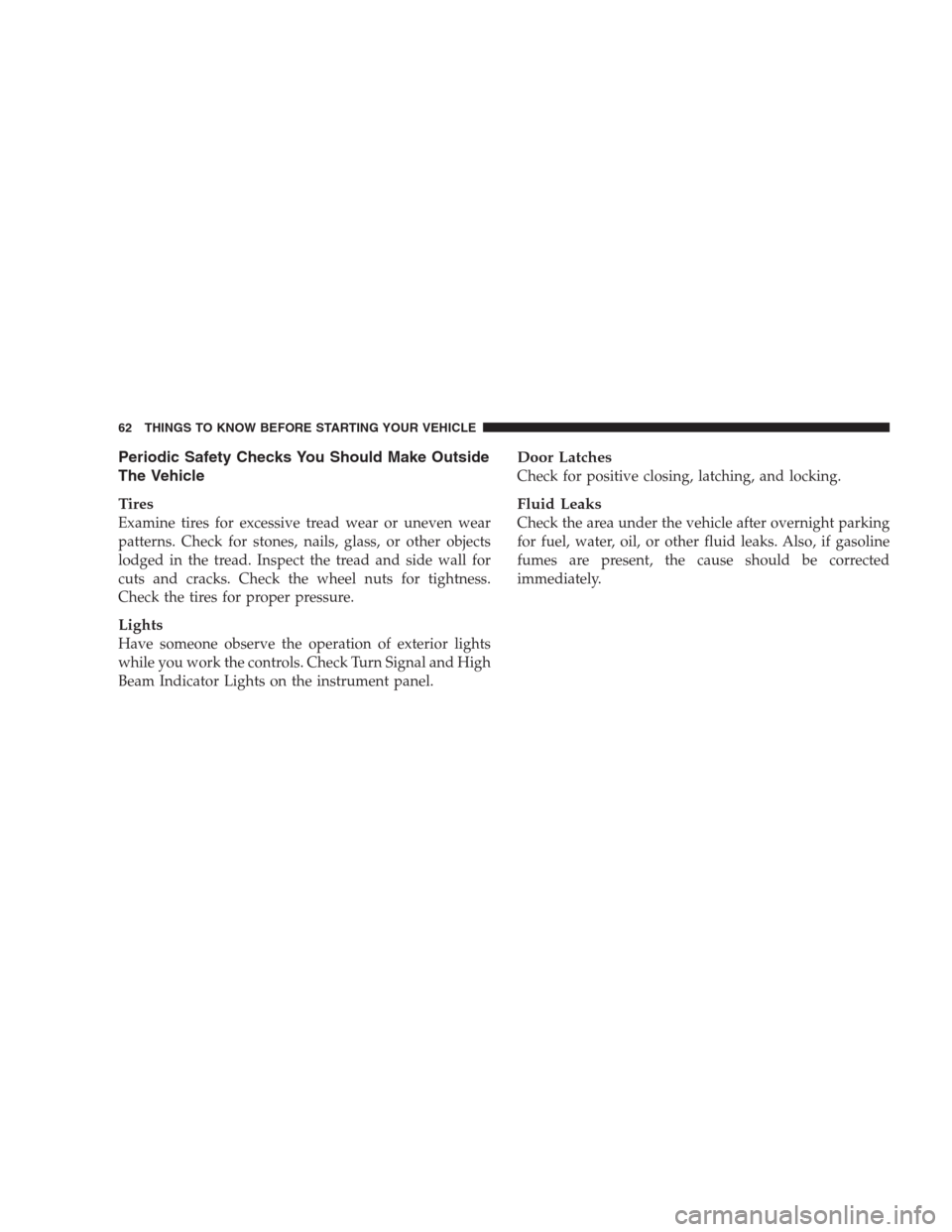
Periodic Safety Checks You Should Make Outside
The Vehicle
Tires
Examine tires for excessive tread wear or uneven wear
patterns. Check for stones, nails, glass, or other objects
lodged in the tread. Inspect the tread and side wall for
cuts and cracks. Check the wheel nuts for tightness.
Check the tires for proper pressure.
Lights
Have someone observe the operation of exterior lights
while you work the controls. Check Turn Signal and High
Beam Indicator Lights on the instrument panel.
Door Latches
Check for positive closing, latching, and locking.
Fluid Leaks
Check the area under the vehicle after overnight parking
for fuel, water, oil, or other fluid leaks. Also, if gasoline
fumes are present, the cause should be corrected
immediately.
62 THINGS TO KNOW BEFORE STARTING YOUR VEHICLE
Page 85 of 299
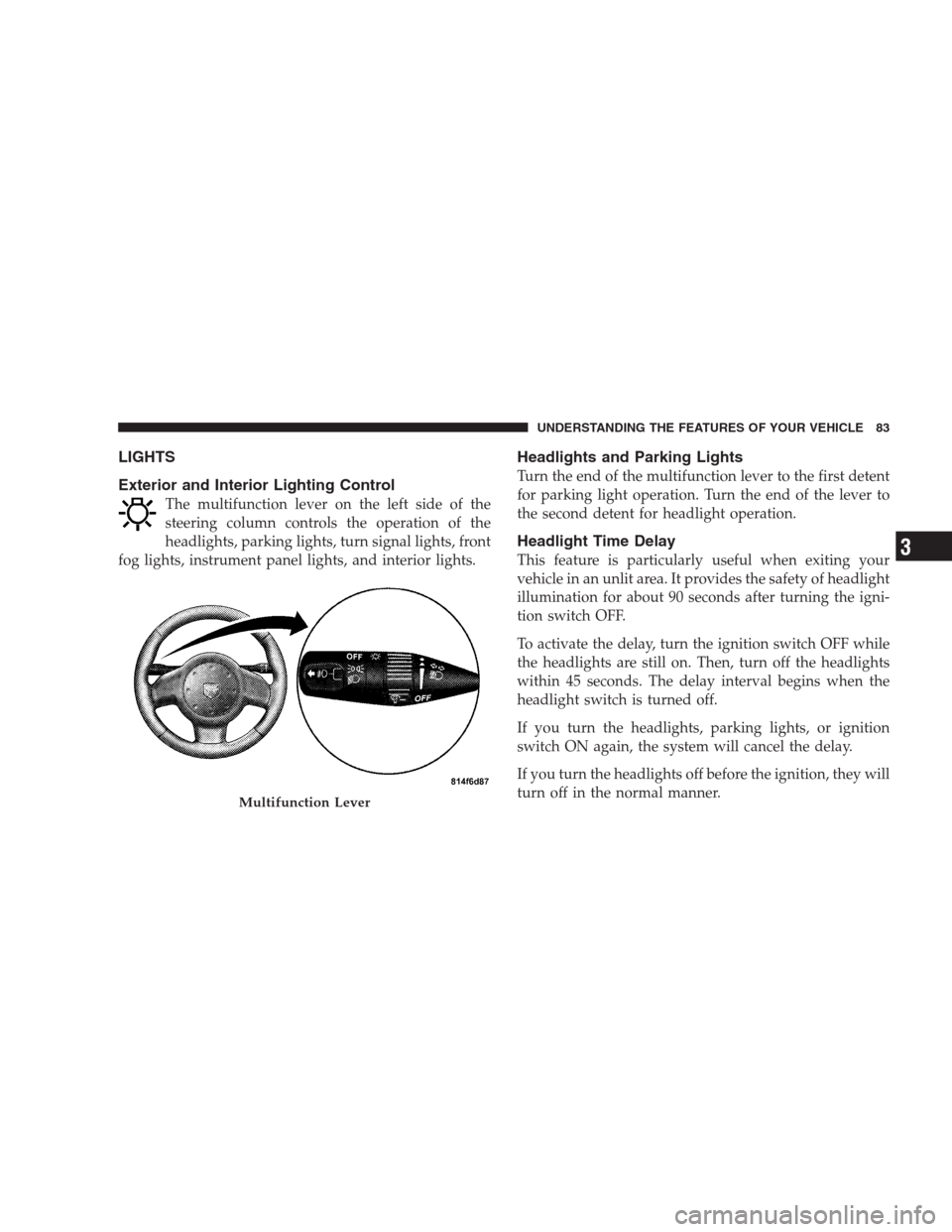
LIGHTS
Exterior and Interior Lighting Control
The multifunction lever on the left side of the
steering column controls the operation of the
headlights, parking lights, turn signal lights, front
fog lights, instrument panel lights, and interior lights.
Headlights and Parking Lights
Turn the end of the multifunction lever to the first detent
for parking light operation. Turn the end of the lever to
the second detent for headlight operation.
Headlight Time Delay
This feature is particularly useful when exiting your
vehicle in an unlit area. It provides the safety of headlight
illumination for about 90 seconds after turning the igni-
tion switch OFF.
To activate the delay, turn the ignition switch OFF while
the headlights are still on. Then, turn off the headlights
within 45 seconds. The delay interval begins when the
headlight switch is turned off.
If you turn the headlights, parking lights, or ignition
switch ON again, the system will cancel the delay.
If you turn the headlights off before the ignition, they will
turn off in the normal manner.
Multifunction Lever
UNDERSTANDING THE FEATURES OF YOUR VEHICLE 83
3